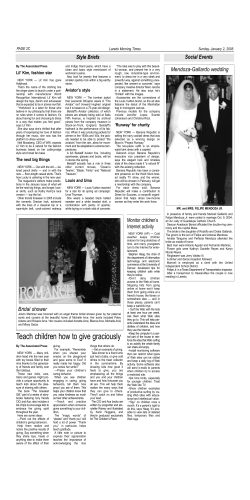
HOW TO HANDLE CORRELATED NOISE IN SEISMIC INVERSION ?
HOW TO HANDLE CORRELATED NOISE IN SEISMIC INVERSION ? Franc¸ois Renard and Patrick Lailly ´ Institut Franc¸ais du Petrole KIM consortium project Annual meeting, Rueil-Malmaison , 2000 December KIM Introduction Earth model that “best” fits the data Seismic inverse problems Minimization of a least squares function In general, use of Euclidian/ norms Lack of realism when the seismic data involve important correlations Objective : a first step towards a solution KIM Outline How to solve an inverse problem ? Bayesian approach determinist approach Waveform inversion Reflection traveltime tomography Conclusion KIM Bayesian approach (1) Formulation of the inverse problem in terms of states of information We have at our disposal a state of information a priori on the data on the unknowns on the theory What is the state of information a posteriori on the unknowns ? KIM Bayesian approach (2) States of information probability density functions (pdf) Use of Gaussian pdf good approximation of the behaviour of many phenomena in nature the associated mathematics are tractable KIM Bayesian approach (3) Dimension N : x=vector is the mean of the distribution is the covariance matrix specifies the uncertainties (diagonal elements) specifies the correlations between these uncertainties (off-diagonal elements) KIM Bayesian approach (4) The Bayesian solution of the inverse problem is the maximum of the a posteriori pdf : , where are the a priori pdf on the data and on the model and parameters Important assumption : independence between these two pieces of information Under the Gaussian pdf assumption KIM Bayesian approach (5) Solution function of the inverse problem is the minimum of the objective KIM is Gaussian is the solution of a linear system Linear case : generalized least squares criterion Determinist approach (1) Minimization of a cost function in model space chosen so as to provide a “relevant” quantification of the deviations from the a priori model requires an a priori knowledge of the confidence we can put on the a priori model KIM in data space chosen so as to provide a “relevant” quantification of the misfits requires an a priori knowledge of the main features of the noise Determinist approach (2) These norms must reflect the confidence we have in the seismic data and in the a priori model, respectively acceptable trade off between contradictory If properly chosen terms The pieces of information on the data and on the a priori model may be dependent Bayesian approach KIM Waveform inversion KIM Waveform inversion - classical formulation (1) Inversion of seismograms Earth model (impedance,...) minimizing is the linear/non linear forward modeling operator KIM In general, use of a norm in the data space Waveform inversion - classical formulation (2) ! Seismograms often corrupted by (high amplitude) correlated noises surface waves multiples tube waves (for VSP records) Inversion of signal + correlated noise unsatisfactory results of inversion norm is not suited for such applications KIM Waveform inversion - classical formulation (3) “Classical” solution filter the noise out inversion using a norm ! There is no perfect filter An inversion approach with a dedicated (semi-) norm in the data space is likely to take the most of the information redundancy correlated noise must not have any effect on the cost function KIM The VSP 1D inverse problem (1) Given VSP records observed at receivers , find the and the source function acoustic impedance distribution that minimize (Mace´ and Lailly, 1986) depth of the first receiver) KIM ( solution of the system The VSP 1D inverse problem (2) Experiment on synthetic data Use of an actual well log impedance 12000 11000 10000 9000 8000 7000 6000 5000 4000 3000 0 200 400 600 depth (ms) KIM The VSP 1D inverse problem (3) Modeling of the associated VSP Corruption by a high amplitude correlated noise KIM The VSP 1D inverse problem (4) impedance x 10 5 2 1.5 1 0.5 0 100 KIM 120 140 160 180 200 220 240 260 depth (ms) Inversion of the noise-corrupted seismogram with the norm The VSP 1D inverse problem (5) New (semi-) norm adapted to the correlated noise KIM b : correlation vector The VSP 1D inverse problem (6) Inversion of the noise-corrupted seismogram with the new (semi-) norm impedance 11000 10000 9000 8000 7000 6000 5000 4000 3000 100 120 140 160 180 200 220 240 260 280 depth (ms) KIM The VSP 1D inverse problem (7) D ✕ d obs ✕ ✕ ✕ f(m exact) f(m2) f(m1) f(M) m1 : Solution with the new formulation KIM m2 : Solution with the classical formulation The VSP 1D inverse problem (8) Conclusions New formulation of waveform inversion in case of seismograms corrupted by correlated noise Demonstration of the efficiency of this new approach on a simple synthetic example Future work case of multiple correlation directions case of dispersive noise real data KIM Reflection Traveltime Tomography (RTT) KIM Reflection tomography - classical formulation (1) find Non linear problem : inversion of traveltimes model velocity/depth that minimizes (Delprat-Jannaud and Lailly, 1993) Solved by a Gauss-Newton algorithm given a current model , minimize KIM Reflection tomography - classical formulation (2) Choice of a (semi-) norm in the model space in If the number of data is sufficient, the linearized inverse problem is well-posed it has a unique solution the solution is all the more stable as is high KIM Reflection tomography - classical formulation (3) is chosen diagonal In practice, diagonal KIM not realistic Very strong assumption : uncertainty associated with data data are considered as mutually independent Reflection tomography - classical formulation (4) A typical survey for a RTT study dense near-offset grid interface geometry few multi-offset lines velocity model KIM Reflection tomography - classical formulation (5) Quite an anisotropic discretization directions along which kinematic data are finely sampled but the correlation of information are not taken into account other directions along which the kinematic data are very sparse enough information ? footprint of the discretization on the a posteriori pdf ... ... and on all derived quantities (solution model, evaluated numerical artifact uncertainties...) KIM Reflection tomography - classical formulation (6) Solution : formalize the kinematic information in an intrinsic way need for a formulation of the continuum problem taking correlations of information into account need for a discretization strategy that allows an accurate approximation of the continuum problem KIM goal : to obtain an intrinsic solution Correlation of information in RTT (1) Choice of a “realistic” covariance operator on the data uncertainties between two points are all the more related as the points are close correlation between two distant points is negligible A classical model : exponential covariance operator ) KIM = standard deviation = correlation length ( Correlation of information in RTT (2) Some realizations of Gaussian random functions with exponential covariance and zero mean Effects of variance changes Effects of correlation length changes variance=0.005 − lambda=0.01 0.4 0.2 0 −0.2 −0.4 0 2 4 6 8 10 variance=0.005 − lambda=0.1 variance=0.005 − lambda=0.1 0.4 0.4 0.2 0.2 0 0 −0.2 −0.2 −0.4 0 2 4 6 8 10 −0.4 0 2 0.2 1 0.1 0.5 0 0 −0.1 −0.5 −0.2 KIM −1 0 2 4 6 4 6 8 10 variance=0.05 − lambda=0.1 variance=0.005 − lambda=1.0 8 10 0 1 2 3 4 5 6 7 8 9 10 Correlation of information in RTT (3) exponential covariance operator is invertible ! ) Associated norm ( Too complex in practice : use of and Too restrictive : must be constant KIM Non independent pieces of information determinist approach Correlation of information in RTT (4) We want to minimize the new cost function KIM Correlation of information in RTT (5) : offset KIM and : CMP coordinates Correlation of information in RTT (6) Main change : solution of the linearized inverse problem KIM “Classical” formulation : New formulation : Correlation of information in RTT (7) Some important results need for a calculation of ray perturbations KIM calculation of impact point perturbations verifies Bending equation velocities KIM explicit interfaces (1) and , Computation of Model and , Computation of (2) Model perturbation KIM First order Taylor expression satisfies Fermat’s principle in Trajectory and Calculation of impact points perturbations solution of Solution of a linear system each ray each model parameter for Computation of second derivatives of time w.r.t. impact point coordinates ( ) KIM ) model parameters ( , Computation of (3) Summary of the new formulation of RTT (1) Data A priori information on the data : KIM A priori information on the model choose of adequate regularization weights Summary of the new formulation of RTT (2) Ray tracing and calculation of the non linear cost function and Computation of Computation of the “classical” Jacobian Formulation of the linearized inverse problem based on the use of the Hessian matrix avoids the storage of 4 huge Jacobians Minimization of the new linearized cost function thanks to a conjugate gradient algorithm KIM Experiments on synthetic data (1) Btert (CASSIS) : parameters Raised by to avoid triplications in the data 1.307 0.000 1.044 13.000 7.000 0.109 X 0.509 2.089 0.908 3.133 1.307 4.178 6.267 0.109 7.311 0.509 8.356 0.908 9.400 1.307 Z 9.400 6.267 5.222 3.133 Z Y KIM 1.000 -5.000 11.000 9.000 7.000 5.000 3.000 1.000 -1.000 13.000 X 0.000 0.109 0.172 0.235 0.299 0.362 0.425 0.488 0.551 0.614 0.677 0.740 0.803 0.866 0.929 0.992 1.055 1.118 1.181 1.244 -3.000 -5.000 Z (km) Y Experiments on synthetic data (2) velocity : Constant parameters X 0.000 0.632 0.947 1.263 1.579 0.429 0.429 0.857 0.857 1.286 1.286 1.714 1.714 2.143 2.143 2.571 2.571 3.000 3.000 Z Z 1.895 2.211 2.526 2.842 3.158 3.474 3.789 4.105 4.421 4.737 5.053 5.368 5.684 6.000 KIM 9.400 8.057 6.714 5.371 4.029 2.686 1.343 0.000 13.000 10.429 7.857 5.286 2.714 0.143 -2.429 -5.000 0.000 0.000 0.316 V e loc ity (km/s) Y Experiments on synthetic data (3) 2 types of data 2400 zero-offset data (regular grid) 8800 multi-offset data, modeled by CMPs in the maximum offset = direction Constant uncertainties for all the data and directions for all the data Progressive decrease of the regularization weights (KIM 99) KIM ) Use of constant arbitrary initial model ( Constant correlation lengths in Experiments on synthetic data (4) Map migration given the velocity, inversion of zero-offset traveltimes to recover the depth of the interface very low misfits KIM Experiments on synthetic data (5) Reflection tomography using multi-offset data very low misfits Validation of the computation of the calculation of the gradient of the cost function How to discretize the kinematic information ? see you next year for constructive answers ! KIM Conclusion (1) Classical formulation of two geophysical inverse problems standard reflection tomography the kinematic information depends on the discretization of the data space the solution of the inverse problem is a numerical artifact waveform inversion the norm in the data space is not adapted to the inversion of seismograms corrupted by very strong correlated noise KIM Conclusion (2) Solution determinist approach waveform inversion use of a (semi-) norm in the data space, adapted to the correlations involved in the noise illustration of the potential of this approach on VSP data reflection tomography Objective : an intrinsic representation of the kinematic information how to discretize this information ? use of a more realistic norm in the data space correlation of information taken into account encouraging experiments on synthetic data more experiments will come soon ! KIM
© Copyright 2025










